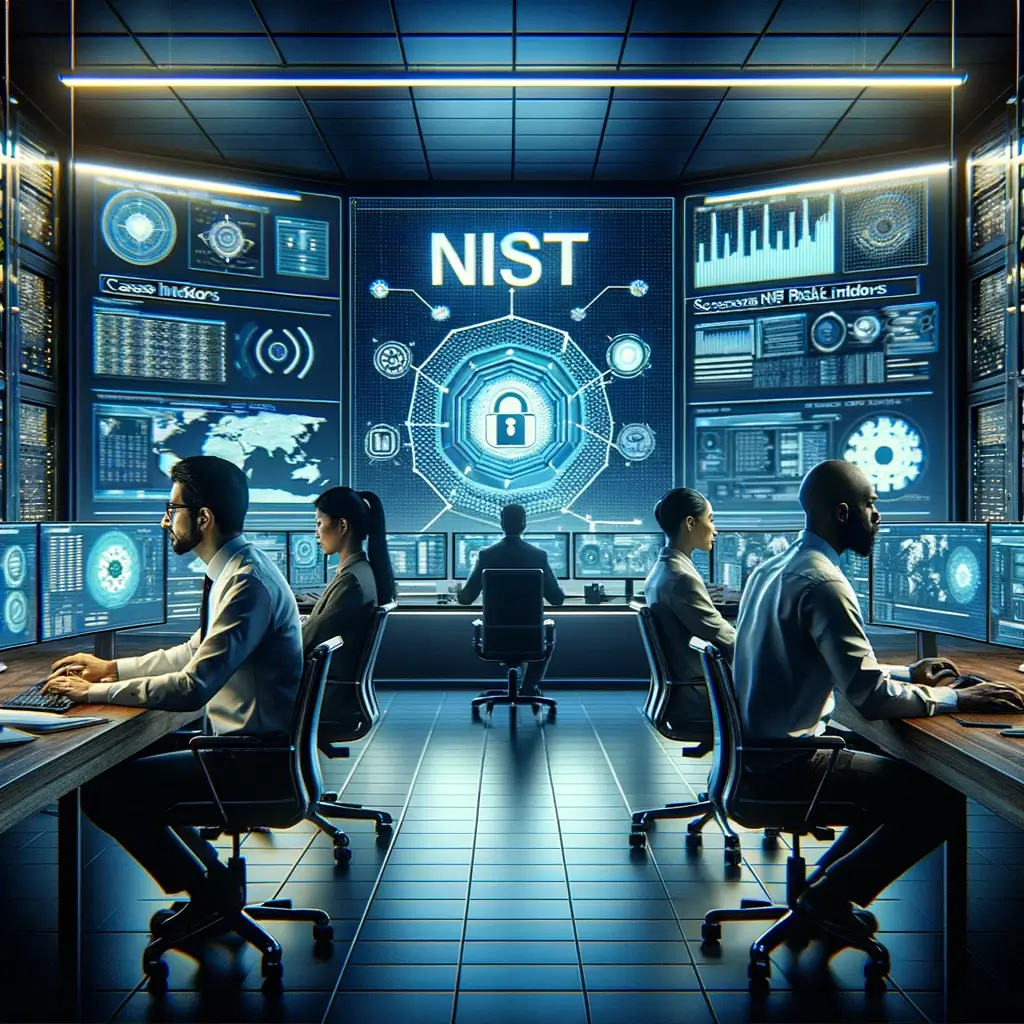Case studies are a powerful tool for organizations looking to improve their cybersecurity posture. By examining real-world examples of successful implementations of cybersecurity frameworks, organizations can gain valuable insights into best practices and strategies for mitigating cyber risks.
One such framework that has gained widespread adoption is the National Institute of Standards and Technology (NIST) Cybersecurity Framework.
The NIST Cybersecurity Framework is a voluntary set of guidelines for improving cybersecurity in critical infrastructure sectors.
It provides a common language and framework for organizations to manage and reduce cybersecurity risks. The framework has five core functions: identify, protect, detect, respond, and recover.
Following these functions, organizations can develop a comprehensive cybersecurity program that aligns with their business objectives and risk tolerance.
This article will explore case studies of successful NIST Cybersecurity Framework implementations. By examining these case studies, readers will better understand how organizations have used the framework to improve their cybersecurity posture and mitigate cyber risks.

The case studies will highlight different sectors, challenges, and strategies, providing various examples for organizations to draw from.
Understanding NIST and Cybersecurity
The National Institute of Standards and Technology (NIST) is a non-regulatory agency of the United States Department of Commerce that develops and promotes technology, measurement, and standards to enhance productivity, facilitate trade, and improve the quality of life.
One of its core focus areas is cybersecurity, which has become a critical issue for individuals, businesses, and governments.
Cybersecurity refers to the practice of protecting electronic devices, networks, and sensitive information from unauthorized access, theft, damage, or disruption.
Cyber threats such as malware, phishing, hacking, and ransomware are becoming increasingly sophisticated, and organizations need to implement effective cybersecurity measures to mitigate the risks.
NIST has developed a Cybersecurity Framework that provides a set of guidelines, best practices, and standards to manage and reduce cybersecurity risks.
The framework comprises three main components: the Core, Implementation Tiers, and Profiles. The Core outlines five functions that are essential to effective cybersecurity risk management: Identify, Protect, Detect, Respond, and Recover.
Each function is further divided into categories and subcategories that provide specific guidance on achieving the desired outcomes.
The Implementation Tiers allow organizations to assess and communicate their cybersecurity risk management practices. There are four tiers: Partial, Risk Informed, Repeatable, and Adaptive.
The tiers reflect how an organization’s cybersecurity risk management practices are integrated into its overall business strategy and are informed by risk management principles.

The Profiles component allows organizations to create a customized roadmap for implementing the Core functions and subcategories based on their unique risk management needs, priorities, and constraints.
The profiles can be used to align cybersecurity activities with business objectives, measure progress, and communicate with stakeholders.
Overall, the NIST Cybersecurity Framework provides a flexible, scalable, and repeatable approach to managing cybersecurity risks that can be adapted to different sectors, organizations, and technologies.
Following the framework, organizations can improve their cybersecurity posture, reduce the likelihood and impact of cyber incidents, and enhance their resilience and reputation.
The Role of Case Studies in Cybersecurity
Case studies have become a valuable tool for organizations to understand and mitigate cybersecurity risks. Organizations can develop effective cybersecurity risk management strategies by examining past incidents and successful strategies. This section discusses the value of case studies and the methodologies and analysis used to evaluate them.
Value of Case Studies
Case studies provide a unique opportunity to learn from real-world scenarios. They allow organizations to identify common vulnerabilities and develop effective mitigation strategies.
Examining successful strategies allows organizations to learn from their peers and improve their own cybersecurity posture.
Case studies also provide a platform for organizations to share their success stories. Highlighting their achievements, organizations can inspire others to adopt similar practices.
This helps create a cybersecurity awareness culture and encourages the adoption of best practices.
Methodologies and Analysis
The analysis of case studies involves identifying the key factors that contributed to the success or failure of a cybersecurity risk management strategy. This involves examining the methods used to identify and mitigate risks, as well as the effectiveness of those methods.
One of the key methodologies used in case study analysis is the identification of cybersecurity risk indicators. These indicators are used to identify potential vulnerabilities and develop effective mitigation strategies.
The National Institute of Standards and Technology (NIST) has developed a set of cybersecurity risk indicators that organizations can use to evaluate their own cybersecurity posture.
Another important aspect of case study analysis is the evaluation of the effectiveness of cybersecurity risk management strategies.
This involves examining the impact of the strategy on the organization’s overall cybersecurity posture. Evaluating the effectiveness of the strategy, organizations can identify areas for improvement and refine their cybersecurity risk management strategies.
Case studies are valuable for organizations to develop effective cybersecurity risk management strategies. Examining successful strategies and identifying key factors that contributed to their success, organizations can improve their own cybersecurity posture.
The methodologies and analysis used in case study evaluation help organizations to identify vulnerabilities and develop effective mitigation strategies.
Key Cybersecurity Risk Indicators
Organizations need to be proactive in identifying and addressing cybersecurity risks. To achieve this, it is important to have a set of key cybersecurity risk indicators (KRIs) that can be used to measure the security program’s effectiveness.
KRIs are metrics that provide insight into an organization’s security posture and help identify potential risks.
Identifying Risk Indicators
Identifying KRIs is not a one-size-fits-all approach. Each organization has unique security requirements and risk tolerance levels. Therefore, it is important to identify the KRIs that are most relevant to the organization.
The National Institute of Standards and Technology (NIST) guides how to identify KRIs in their Cybersecurity Framework. The framework recommends that organizations identify KRIs based on the following criteria:
- Relevance: KRIs should be relevant to the organization’s security objectives and goals.
- Criticality: KRIs should reflect the criticality of the assets being protected.
- Measurability: KRIs should be measurable and quantifiable.
- Timeliness: KRIs should provide timely information to enable proactive risk management.
Metrics and Measurement
Once KRIs have been identified, measuring and monitoring them is important. This involves establishing a baseline for each KRI and monitoring changes over time.
Metrics should be established for each KRI and used to measure the security program’s effectiveness. The metrics should be reviewed regularly to ensure that they remain relevant and effective.
Best practices for measuring KRIs include:
- Establishing a baseline: A baseline should be established for each KRI to provide a reference point for future measurements.
- Regular monitoring: KRIs should be monitored regularly to detect changes and potential risks.
- Trend analysis: Trend analysis can help identify patterns and potential risks.
- Reporting: KRIs should be reported regularly to senior management to provide insight into the organization’s security posture.
Identifying and measuring KRIs is an essential part of any cybersecurity program. Organizations should identify KRIs that are relevant, measurable, and reflect the criticality of the protected assets.
Metrics should be established for each KRI and monitored regularly to detect changes and potential risks. By following these best practices, organizations can proactively manage cybersecurity risks and ensure the security of their assets.
Cyber Supply Chain Risk Management
Cyber Supply Chain Risk Management (C-SCRM) is a critical component of an organization’s risk management program.
It is the process of identifying, assessing, and mitigating the risks associated with using information and communications technology (ICT) products and services in an organization’s supply chain. C-SCRM is essential to ensure the organization’s ICT supply chain is secure and resilient.
Frameworks and Standards
Several frameworks and standards are available to guide organizations in implementing effective C-SCRM programs.
The National Institute of Standards and Technology (NIST) has developed a comprehensive set of guidelines for managing ICT supply chain risks, including NIST SP 800-161, which guides identifying, assessing, and mitigating cyber supply chain risks.
NIST also offers a C-SCRM framework to help organizations implement effective C-SCRM programs.
Other frameworks and standards that can be used to guide C-SCRM include the ISO/IEC 27001 Information Security Management System (ISMS), the Open Group Trusted Technology Forum (OTTF) Open Trusted Technology Provider Standard (O-TTPS), and the Center for Internet Security (CIS) Controls.
Implementation Strategies
Implementing a successful C-SCRM program requires a comprehensive approach that includes third-party risk management, external dependency risk management, and supply chain assurance. The following are some strategies that organizations can use to implement effective C-SCRM programs:
- Conduct a comprehensive risk assessment of the organization’s ICT supply chain to identify potential risks and vulnerabilities.
- Develop and implement policies and procedures for managing ICT supply chain risks.
- Establish a process for selecting and approving suppliers and service providers based on their ability to meet the organization’s security requirements.
- Monitor and assess the security posture of suppliers and service providers continuously.
- Establish a process for responding to security incidents and breaches in the ICT supply chain.
- Conduct regular training and awareness programs for employees and contractors to ensure they understand their roles and responsibilities in managing ICT supply chain risks.
In conclusion, C-SCRM is essential to an organization’s risk management program.
Implementing effective C-SCRM programs ensures that organizations’ ICT supply chains are secure and resilient, better preparing them to respond to cyber threats and attacks.

Industry-Specific Cybersecurity Practices
NIST’s Cybersecurity Framework provides a set of guidelines and best practices that can be applied across various industries.
However, certain industries have unique characteristics and requirements that may necessitate specific cybersecurity practices. This section will explore some industry-specific cybersecurity practices that have successfully reduced cybersecurity risks.
Health Sector
The health sector is responsible for storing and managing sensitive patient data, making it a prime target for cyberattacks. Data encryption is one of the most critical cybersecurity practices for the health sector.
Encrypting patient data can prevent unauthorized access to sensitive information. Additionally, healthcare organizations should implement multi-factor authentication to ensure only authorized personnel can access patient data.
Energy and Environment
The energy and environment sector manages critical infrastructure such as power plants and water treatment facilities.
Cyberattacks in this sector can have severe consequences, including power outages and environmental disasters. A crucial cybersecurity practice for this sector is network segmentation. Network segmentation can limit the damage caused by cyberattacks by isolating critical systems from the rest of the network.
Infrastructure and Electronics
The infrastructure and electronics sector is responsible for building and maintaining critical infrastructure such as roads, bridges, and airports.
Cyberattacks in this sector can cause significant disruptions to transportation and other critical services. A critical cybersecurity practice for this sector is vulnerability scanning.
Vulnerability scanning can identify weaknesses in the network and applications before cybercriminals can exploit them.
Implementing industry-specific cybersecurity practices can help organizations reduce cybersecurity risks. The health sector should focus on data encryption and multi-factor authentication, while the energy and environment sector should implement network segmentation.
The infrastructure and electronics sector should focus on vulnerability scanning.

Chris Ekai is a Risk Management expert with over 10 years of experience in the field. He has a Master’s(MSc) degree in Risk Management from University of Portsmouth and is a CPA and Finance professional. He currently works as a Content Manager at Risk Publishing, writing about Enterprise Risk Management, Business Continuity Management and Project Management.

